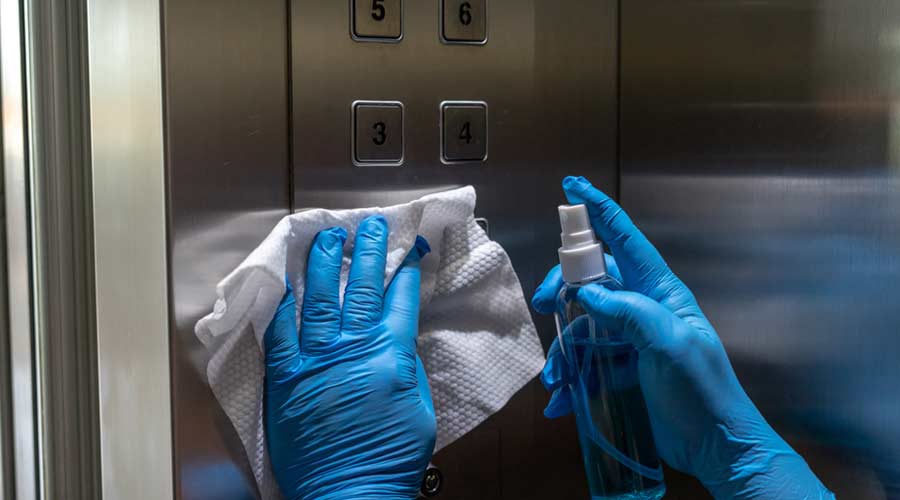
Hurricanes are not uncommon in Tampa, Florida, but the double punch of Hurricanes Helene and Milton in the fall of 2024 was a challenge for Mike Steger, director of Facilities Management for Berkeley Preparatory School.
“With Helene, I don’t think most of us fully understood the possible impact of the storm surge,” Steger says. “It is amazing the amount of damage that much water can cause ... and of course it's not just sea water. As that water moved inland, it picked up all sorts of flotsam and jetsam and who knows what else along the way.”
Steger says Berkeley Preparatory School suffered storm surge flooding from Helene in 55,000 square feet of the school's 390,000 square feet of facilities. This included 22 classrooms, an administration building, the library, a gymnasium and locker rooms, and three off-campus houses. The spaces were overrun with very corrosive salt water, recalls Steger.
Like Daigle, Steger's first move was to call the remediation company his school partners with.
“I made the call for service while the storm was still happening, making sure we were on their response list early,” he explains.
The remediation team arrived the following morning and, with Steger's team, began the process of assessing the extent of the damage, while simultaneously starting the process of making areas safe from an electrical standpoint and removing water. Having the remediation company on site “allowed our in-house facilities team to assess the remaining buildings on campus, then begin the process of the clean-up from other water intrusion and wind damage,” he adds.
Steger recalls that the remediation teams went to work removing the water, the affected furniture, contents, and carpet tiles, as well as cutting out the lower 3 feet of drywall. This quick response helped mitigate further impact from the water in places that could not be easily seen.
There was one issue with sourcing supplies, according to Steger. The affected classrooms had a vinyl-covered sound panel that was on all the walls, and carpet tiles. These required longer lead times, but the team improvised. It was about a month before the classrooms welcomed students back, but they eventually opened sans carpet or the sound panels until the winter break when the team could tackle the space with the appropriate supplies.
“There were bare concrete floors and unfinished drywall or block walls, but the students were back in their primary learning spaces,” says Steger.
Meanwhile, the administrative offices took roughly six weeks to reopen. Office furniture was another long lead item, so school staff moved back to offices with bare concrete floors and were working from folding tables. According to Steger, the furniture arrived in early January, and everything is finally back to normal.
Lessons Learned
Daigle admits his district doesn't have a detailed plan in place for natural disasters and instead relies on his experience.
“You know, we don't have a written plan, but this is probably my seventh flood in the district since I've been here, whether it's from runoff that's getting into the buildings or broken pipes, contractor mistakes during a roofing project, things like that. Even vandalism,” he says. “I go into auto-drive at that point. My first calls go out to the remediation company, and then I'm following that up with whoever I need to as far as doing restorations.”
This is a short-term option for CBMS. At some point, Daigle is going to retire and will take that experience with him when he goes. No matter how well a manager can respond to a natural disaster, experts recommend having a written disaster plan in place. At Berkeley Prep, Steger has a general response checklist that they follow.
“Our priority is to make the areas safe and begin the process of clean-up, while making plans for how we will recover from the damage being assessed,” says Steger. “We keep it general to allow us to remain flexible, understanding that the issues needing to be addressed may be different from event to event.”
Concerning potential natural disasters, Daigle's advice to facilities managers is to look around the facility and consider the worst-case scenario, then put a plan together for each of those. Second to that, have trusted resources.
“Build relationships with your remediation companies. Have a solid relationship with your insurance company,” says Daigle. “We've got a great insurance company the school district uses. We're a team.”
Steger offers parallel advice. He recommends making plans early and regularly reviewing them with the team.
“The time to pull that manual off the shelf is not when the storm is bearing down upon you,” he says.
Steger admits they became complacent in their pre-storm preparations. Because there hasn’t been storm surge flooding in decades, they were lax about unplugging equipment and getting the contents of rooms up off the floors. Their preparations were largely focused on wind damage or minor wind-driven rain intrusion.
“We were not prepared for 6 to 8 inches of dirty sea water to seep into our buildings,” says Steger. “The lesson learned is that we need to take all warnings seriously and prepare as if we were expecting hurricane-force winds and storm surge or significant flooding impacts.”
He also suggests partnering with a disaster recovery company.
“The resources they brought to bear in terms of personnel, equipment (extractors, drying equipment, etc.), and trade partnerships (drywallers, electricians, plumbers, etc.) is invaluable.”
He went on to suggest that it is helpful to have “disaster partnership” conversations with your own contract partners.
“Ask if they would be willing to make your institution a priority in a recovery situation. Just knowing that you’ve got a committed partner to call on when disaster strikes is very comforting.”
Shannon O’Connor is a freelance writer from Mason, Ohio.
Steps to Bouncing Back from Damaging Weather

 The Down and Dirty on Cleaning in Virus Season
The Down and Dirty on Cleaning in Virus Season How Surfactant Use is Expanding in Commercial Cleaning
How Surfactant Use is Expanding in Commercial Cleaning